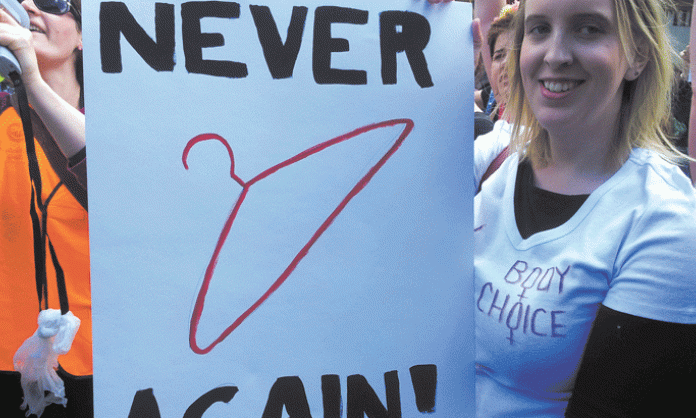Writing in the Communist (UK) in 1922, activist and sometimes socialist Stella Browne insisted that birth control “is no less essential than workshop control and determination of the conditions of labour … Birth control is woman’s crucial effort at self determination and at control of her own person.”
This demand for women’s control of our bodies has been the basis for mass campaigns to win repeal of abortion laws.
Abortion wasn’t always regulated by the state. It was the rise of capitalism and the need for the nuclear family to produce and reproduce the next generations of workers that brought focus on women’s reproductive role.
In England capitalism decimated the labouring population through crippling work in factory hellholes. Only after this did the state introduce laws controlling abortion and other aspects of reproduction and sexuality.
Based on English law, Australian abortion laws from the beginning were ambiguous. They allowed some leeway for doctors legally to terminate pregnancy, but the operations were expensive and the ambiguities in the law opened the door to corruption.
For those who couldn’t get through the legal hoops, but could scrape up the money, there were doctors available. But for those with little cash, backyard operators (sometimes retired midwives) or other desperate remedies were the only option. The hospitals filled with women suffering the after effects, sometimes fatal, of botched operations.
1960s radicalisation
By the late ’60s, pressure was mounting to bring an end to the protection rackets and increase the availability of abortions. Importantly, the contraceptive pill, expensive as it was in Australia (it had a “luxury” tax put on it), gave women sexual freedoms they hadn’t had before. Economic boom increased the demand for female labour, which in turn fostered confidence among women workers to fight for their rights.
Initially, the push to change abortion laws came from civil liberties groups and the medical profession. This resulted in Victorian and New South Wales court rulings that broadened the basis for abortion. But it was still doctors who controlled the process.
Alongside the worldwide rise in working class militancy, a radicalising women’s movement emerged. Top of the list of demands was women’s control over our own bodies – repeal of all abortion laws and free, safe abortion, sex education and contraception on demand.
This was coupled with demands to end forced sterilisation of Aboriginal and intellectually disabled women. Linking all these demands to access to free 24-hour child care and equal pay focussed the campaigns on working women’s rights in the fight for women’s liberation and against oppression.
The newly formed Women’s Abortion Action Committee wanted more than piecemeal reforms. Instead of patient lobbying, it argued that mass action campaigns could deliver fundamental change.
Only this type of campaign could, they wrote, “take on the myths and prejudices which surround this issue, that make women ashamed to even speak of abortion, let alone admit that they have had one. And only this type of campaign can fight the reactionary media, church men and politicians who daily intimidate women into believing they have no right to control their own bodies.”
Starting with small numbers – such as the Mother’s Day demonstration in Melbourne in 1971, where the slogan “Contraceptives not chrysanthemums” accompanied the demands for free contraception, family planning clinics and free abortion on request – the rallies drew several thousand around the country.
International Women’s Day marches also carried banners with the abortion campaign demands.
Campaigns such as these helped build majority support for women’s right to choose. As well, pressure from below forced the Whitlam government to remove the luxury tax from the pill and enable Medicare funding for abortions.
Winning union support
For decades, working women supported demands for access to birth control, for reproductive rights and for the unions to support these demands. The Communist Party and other socialists were early supporters of women’s rights and promoted women’s demands as union demands.
Working women and socialists have convinced trade unions to support demands like maternity leave, equal employment opportunity, improved provision of child care and affirmative action.
While not openly supporting the right to abortion, by the late 1970s the Australian Council of Trade Unions policy called for “access for all couples and individuals to the necessary information, education and means to exercise their basic right to decide freely and responsibly on the number and spacing of their children”.
Left wing unions used this to officially support abortion as an industrial issue and to back pro-abortion campaigns such as the successful fight in Queensland over 1979-80 to force the Bjelke-Petersen government to drop a draconian new bill.
Unions recognised that without the right to choose, women didn’t have the same access to jobs. And it wasn’t just the female-dominated unions that took a lead.
A series of unions donated money, joined picket lines or arranged job site meetings. A picket outside parliament in December 1979 was endorsed by 13 union officials, with members of the Transport Workers Union joining in and the Trades and Labour Council passing a motion opposing a restrictive bill.
Although legally abortion remains within the Crimes Act in all but two states, we’ve come a long way from the backyard abortions and corruption of the ’50s and ’60s. However, access as well as “rights” is crucial for working class women, so issues such as the cost of contraceptives, doctors’ bills, access to hospital care and the like still need to be campaigned about.
Stella Browne summed up what we’re still fighting for: “Abortion … should be available for any woman without insolent inquisitions, nor ruinous financial charges, nor tangles of red tape. For our bodies are our own.”











